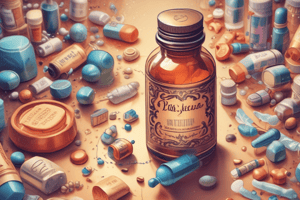Podcast
Questions and Answers
What change in the hydrolytic resistance of Type III sodalime-silica glass containers will result in a classification change to Type II?
What change in the hydrolytic resistance of Type III sodalime-silica glass containers will result in a classification change to Type II?
- Increasing the sodium oxide content
- Reducing the silicon dioxide content
- Treating the inner surface (correct)
- Adding more aluminum oxides
Which USP glass classification is described as having low leachability and high thermal stability?
Which USP glass classification is described as having low leachability and high thermal stability?
- Type III
- Type IV
- Type I (correct)
- Type II
What characterizes Type I glass in terms of its composition?
What characterizes Type I glass in terms of its composition?
- High aluminum oxide levels
- Rich in calcium oxide
- Predominantly silicon dioxide and boric oxide (correct)
- High sodium oxide content
Which type of glass is chemically less resistant but easier to mold into shapes due to its composition?
Which type of glass is chemically less resistant but easier to mold into shapes due to its composition?
What treatment has Type II glass containers undergone to improve their properties?
What treatment has Type II glass containers undergone to improve their properties?
What type of glass is suitable for most pharmaceutical products according to USP?
What type of glass is suitable for most pharmaceutical products according to USP?
Which type of glass has a lower concentration of migratory oxides compared to the other?
Which type of glass has a lower concentration of migratory oxides compared to the other?
What characteristic makes Type I glass more stable against thermal expansion stress?
What characteristic makes Type I glass more stable against thermal expansion stress?
Flashcards are hidden until you start studying




